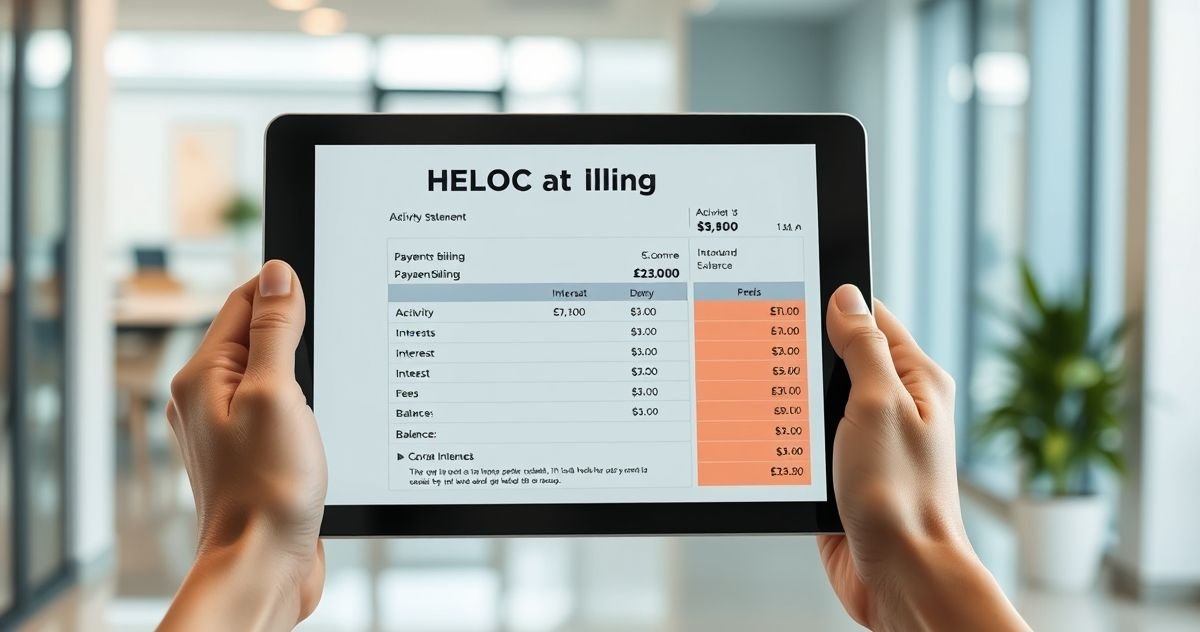A Home Equity Line of Credit (HELOC) billing statement is a detailed report your lender sends you each month outlining all transactions, payments, interest charges, fees, and your overall account status. Understanding the components of your HELOC statement is essential for managing your line of credit responsibly and avoiding costly surprises.
Key Sections of a HELOC Billing Statement
- Account Summary: This section provides a snapshot of your HELOC account, including:
- Previous Balance: The amount owed at the end of the last billing cycle.
- New Advances/Draws: Funds newly borrowed during this period.
- Payments & Credits: Any repayments or credits applied.
- Interest Charged: Interest accrued based on your outstanding balance.
- Fees: Charges for late payments or other account-related fees.
- New Balance: Your total balance after accounting for draws, payments, interest, and fees.
- Credit Limit and Available Credit: The maximum borrowing limit minus your current balance.
-
Transaction Details: Lists every financial activity on your HELOC, including dates, descriptions (such as checks written or payments made), amounts, and the updated balance after each transaction. This helps ensure your records match your lender’s.
-
Payment Information: Critical information about your required payment, including:
- Minimum Payment Due: The smallest amount you need to pay to avoid penalties.
- Payment Due Date: The deadline for your payment.
- Payment Methods: How to submit your payment (online, mail, phone).
- Late Payment Warning: Penalties and interest rate changes if you miss the payment.
- Interest Rate Details: Since most HELOCs have variable rates, this section outlines:
- Annual Percentage Rate (APR): Your current interest rate.
- Index and Margin: The benchmark rate plus a lender’s margin that determine your APR.
- Interest Calculation Method: How the interest is computed, often based on your average daily balance.
- Important Messages & Disclosures: Updates on account terms, notices about the draw or repayment periods, privacy policies, or year-end tax statements.
Practical Example
If Jane had a previous HELOC balance of $15,000, borrowed $2,000 more, paid $200, and was charged $75 interest this month, her new balance would be $16,875 ($15,000 + $2,000 – $200 + $75). Her statement would show these details along with her minimum payment due and available credit.
Tips for Reviewing Your HELOC Statement
- Review promptly to catch errors or discrepancies.
- Confirm all draws and payments are accurate.
- Monitor your APR and be aware that it can fluctuate.
- Never miss your payment due date to avoid fees or credit impacts.
- Pay more than the minimum when possible to reduce principal faster.
- Contact your lender if you notice errors or have questions.
Common Myths Clarified
- You pay interest only on the amount borrowed, not the total credit limit.
- HELOC payments vary based on balance and interest rate changes; they are not fixed like some loans.
- Although similar to credit cards in format, HELOCs have unique features like being secured by your home and often having different repayment structures.
Frequently Asked Questions
Why does my HELOC payment change month to month?
Your payment changes due to variable interest rates and changes in your outstanding balance from draws or payments. Learn more about variable interest rates.
What is the draw period?
The draw period is typically 5–10 years when you can borrow and often make interest-only payments before principal payments begin. See Draw Period.
Can I pay off my HELOC early?
Yes, usually without penalty. However, check if your lender charges any early closure fees.
What if I can’t make the minimum payment?
Contact your lender immediately to discuss options and avoid fees or credit damage.
For comprehensive details, visit the Consumer Financial Protection Bureau’s guide to HELOCs.



